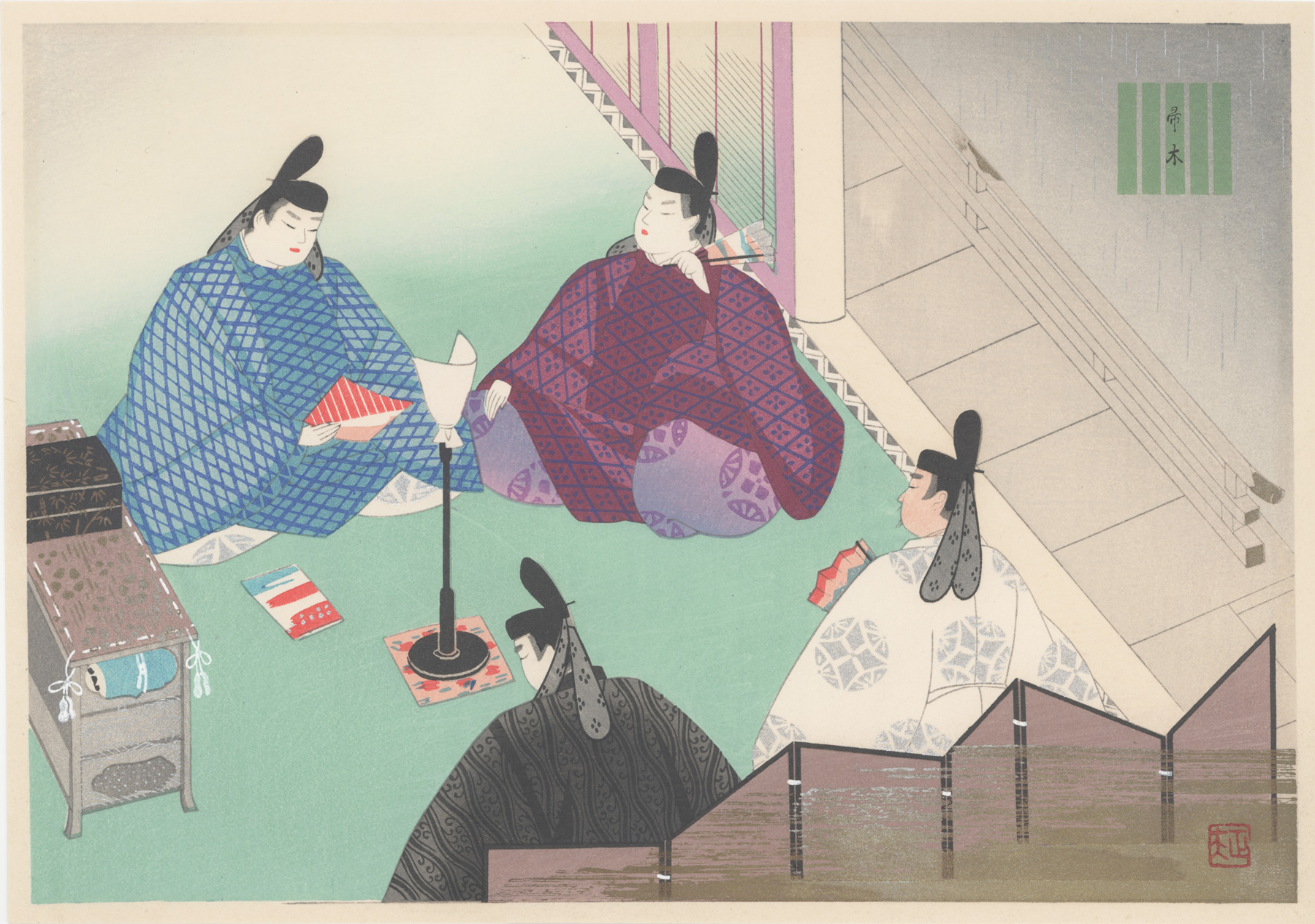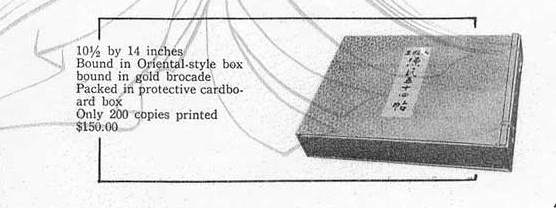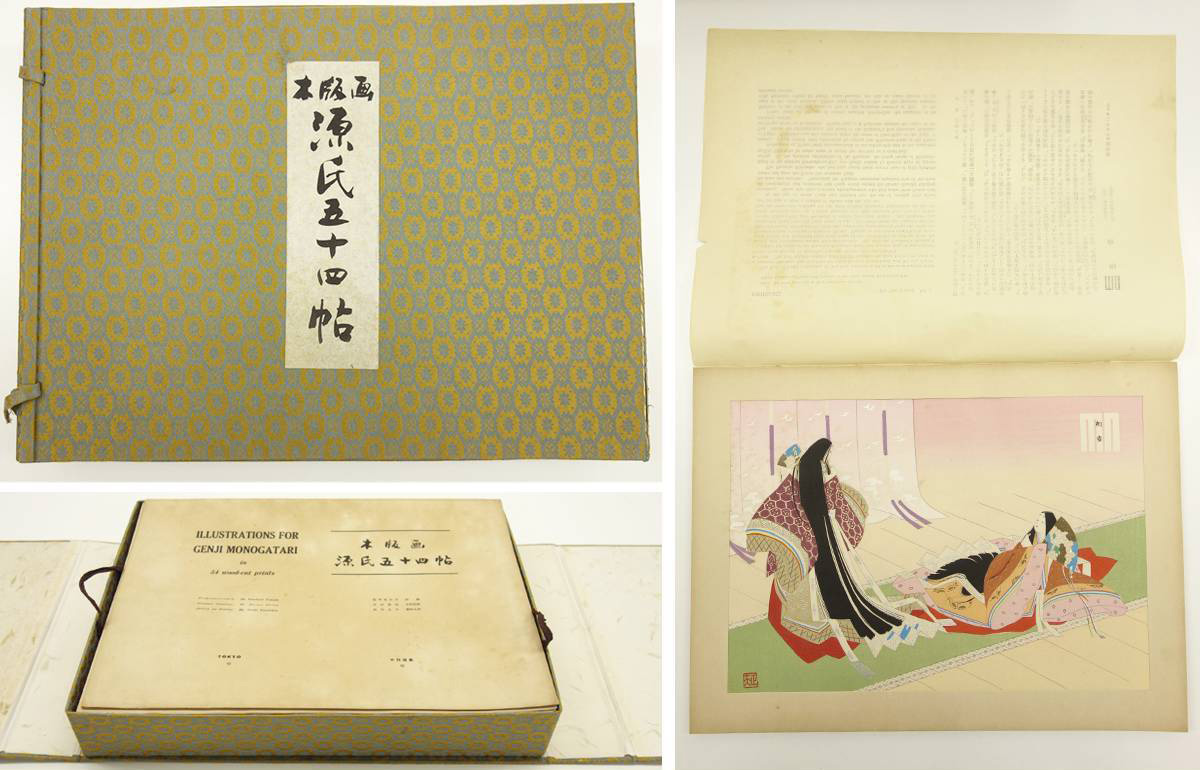About This Print
In this scene from chapter 2, Hahakigi, the seventeen year old Prince Genji, pictured in the blue robe, isreading love letters from admirers to his friends Tō-no-Chūjō,Sama-no-Kami and Tō Shikib-no-Jiō. They then go on to discuss various aspectsof women, as in the below statement by Tō-no-Chūjō :
Source: The Tale of Genji, Lady Murasaki, Dead Authors Society, 2018
It is with women as it is with everything else: the flawless ones are very few indeed. This is a sad fact which I have learned over the years. All manner of women seem presentable enough at first. Little notes, replies to this and that, they all suggest sensibility and cultivation. But when you begin sorting out the really superior ones you find that there are not many who have to be on your list...
About The Album
Originally issued in 1953 in a limited edition of 200 copies by the Tokyo-based publisher Yamada Shoin, owned by Yonekichi Yamada, Illustrations for Genji monogatari in Fifty-Four Wood-Cut Prints was reissued several times by the publisher, using the original woodblocks. Dr. Ross Walker on his Ohmi Gallery website notes that "a second edition was published in the 1980s but from recarved blocks and in a much larger format (large-oban size)."1 The Artelino website makes mention of a "privately commissioned" edition but provides no additional information. In January 1974, a machine printed version of the entire album, simply titled Genji gojūshijō 源氏五十四帖, was issued by two Kobe-based publishers, Kenzō Ōe (associated with the publisher Shin Kōbe Shinbunsha) and Ochiai Miyoji (associated with the publisher Gakunan Shimin Shinbunsha). The printer for this album was Nissha Printing Company Ltd. which is still in operation today.
For collectors, it is difficult to know what edition (original or reissue using the original woodblocks) an individual print is from if it has been separated from its album, as is the case with this collection's prints.
The production of the woodblock prints was a tour de force. As described by the publisher Yonekichi Yamada, up to one hundred blocks were used for an individual print in order to "capture the complex and delicate coloring of the Yamato-e style paintings on which these prints are based."2 In addition, deluxe woodblock printing techniques such as the use of metallic gold and silver inks were employed.
Note: my notes below appear in italics within brackets [ ].
The Project and the Publisher:
Mr. Yonekichi Yamada with his experience of thirty years in art publication began to undertake the publication of this album in 1953 at his own expence [sic] and sacrificing his personal interest.
Since then, overcoming a number of technical difficulties, he has put his whole heart and soul, helped by several woodblock artists, into realizing the woodblock art of the highest standard.
Their persistent efforts and the propriety as subject matter of Genji Monogatari which is the culmination of our early literature, enabled the publication of this album which reproduces very well the elegant manners of the Heian period. It is not surprising that it has won the highest praise as an album most graceful of this art ever known.
Planner and Chief Editor
Yonekichi YAMADA, the President of YAMADA SHOIN, the publisher
Painter of Original Pictures
Masao EBINA, Winner of 'Hakuji' and Special Prizes
Supervisor of Wood Carving
Yoshio KAWAMO [Kawatsura Yoshio 川面義雄 (1880-1963)*]
Chief Producer
Ryohei NAGAYA
Explainer and Translator
Takei MATSUDA, Litt. D. [Matsuda Taeko 松田武夫 (1904-1973)]
General Supervisors
Isojo, ASOO, Litt.D., Dean of Liberal Arts Faculty, Tokyo University [Asō Isoji 麻生磯次 (1896-1979)*]
Sen-ichi HISAMATSU, Litt. D. the Honorable Prof. of Tokyo University, Member of the Japan Academy
[Hisamtasu Sen'ichi 久松潜一次 (1894-1976]* Kawatsura Yoshio, an artist in his own right, joined Yamada Shoinin 1941 as a printing engineer/supervisor. Prior to reproducing Ebina’s Genjipaintings in woodblock, he had reproduced a number of original Genji-related works for Shoin and other publishers. Hewas awarded the Medal with Purple Ribbon for his contributions to artistic developments in 1959.
The original 1953 release
Each print has a translucent cover sheet which summarizes
the scene being portrayed and its chapter
Text of the Foreword to the Original Edition
Thus in GENJI MONOGATARI, which is enriched with fine characterization, character-building is consistently sought after. The whole subjects and design of this long novel not only testify to this, but also the delineation of main characters show how men grow up and build up their character. This can be said of the hero, Prince Genji and other persons such as Kaoru-no-Kimi, Fujitsubo-no-Nyōgo, Murasaki-no-Ue, Akashi-no-Ue and Ukifune.
In the case of Murasaki-no-Ue and Akashi-no-Ue, they show a steady growth toward the building of their character from beginning to end, while such women as Fujitsubo-no-Nyōgo and Ukifune complete their spiritual growths only after they make blunders in their love affairs. In the latter case, the problems of sexual desires, morality and religion are also involved.
One would be unfairly prejudiced if one should criticize GENJI MONOGATARI from the moralistic or religious standpoints alone. Motoori Norinaga (1703-1801)rightly appreciated this literary masterpiece when he criticized it from his standpoint of human emotions. Based upon this interpretation, we should conclude that this literary work involves the problems of morality and religion since it is a full expression of humanity.
This unique love romance GENJI MONOGATARI, was translated in part into English by Fr. Kenchō Suematsu (1855-1929), and then the entire English translation of this novel was completed by Dr. Arther [sic] Waly. Since then, it has come to be widely read in Europe and America, its artistic value in world literature being recognized by degrees.
Dr. Sen-ichi Hisamtasu,
Honorary Professor at Tokyo University.
To view a complete set of the original album go to
1 website of Dr. Ross Walker's Ohmi Gallery https://www.ohmigallery.com/DB/Artists/Sales/Ebina_Masao.asp [accessed 3/24/2021]
2 from the publisher's booklet accompanying the original 1953 releasePrint Details
| IHL Catalog | #2457 |
| Title or Description |  variously translated as The Broom Tree or Broom Cypress |
| Series | Illustrations for Genji monogatari in Fifty-Four Wood-Cut Prints 木版画源氏五十四帖 Mokuhanga Genji gojūyonjō |
| Artist | Ebina Masao (1913-1980) |
| Signature | not signed |
| Seal | 正夫 Masao |
| Publication Date | 1953 or after (originally issued 1953; multiple editions are known) |
| Publisher | Yamada Shoin 山田書院 |
| Carver | carving supervised by Yoshio Kawamo [Kawatsura Yoshio 川面義雄 (1880-1963)] |
| Printer | |
| Impression | excellent |
| Colors | excellent |
| Condition | excellent |
| Genre | genji-e |
| Miscellaneous | |
| Format | ōban |
| H x W Paper | 8 3/4 x 12 1/2 in. (22.2 x 31.8 cm) |
| H x W Image | 8 5/16 x 12 1/8 in. (21.1 x 30.8 cm) |
| Collections This Print | Ruth Chandler Williamson Gallery, Scripps College 2018.1.74; University of Kansas Libraries KU Bib ID: 4123242 (entire album; images not shown); National Diet Library Call Number 913.36-E17g-K (entire album dated 1958; images not shown) |
| Reference Literature | |
3/23/2021 created




